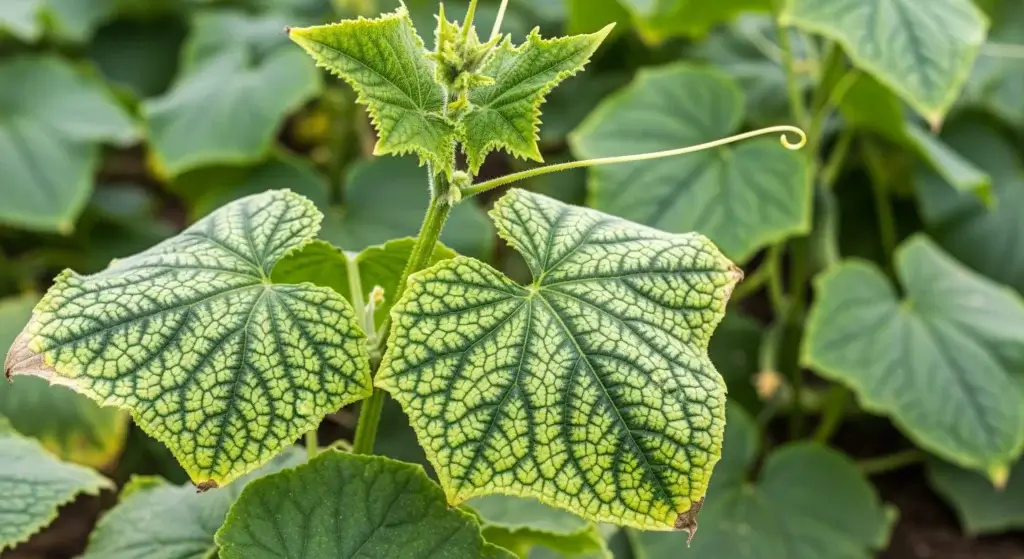
Though it sounds like a sophisticated wizard spell, trust me, fusarium wilt is more “dark magic” than a beneficial herb.
Faster than you could say “wilted tomato,” this annoying fungus disease may creep into your garden and wreak havoc on your plants.
Fortunately, though, we are not allowing this fungus monster to prevail.
This book will teach you how to recognize the warning signals and engage in effective, natural resistance.
See it as the very own superhero training montage for your plant.
Let’s kick Fusarium to the compost heap so your garden will flourish once more!
What Is Fusarium Wilt?
Now, here’s the dirt: Fusarium Wilt, a cunning little fungus living in the soil that attacks your plants from the roots up, causes fusarium wilt.
Consider it as the plant equivalent of a blocked artery; once it enters your plant, it inhibits the “plumbing system,” therefore restricting the water and nutrient flow.
Next? Not good, buddy:
- Your plants stop growing as they used to.
- Leaves begin to turn yellow—not in a lovely autumnal manner.
- They wither and sag like though they have saw a depressing film.
- And should it be kept untreated? Complete plant breakdown.
The most aggravating aspect is a master of deception, fusarium resembles drought stress.
You’re out here watering like crazy, believing your plant is simply thirsty, while this fungus is hosting a garden party under ground.
- Read also: Garden Detectives: Cracking The Signs of Pest in Vegetables
- Read also: Stress-Free Gardening: Top Tips to Protect Vegetables From Pests

How Does Fusarium Spread?
Fusarium is like the horror movie villain of the garden—it lurks in the background, waits patiently, and pops up when you least expect it.
These fungal spores can hang out in the soil for 5 to 10 years like they’re paying rent… even if there are no plants around. Yep, it’s that stubborn.
Here’s how it gets around:
- Dirty tools or soil – If your shovel, pots, or boots have been in infected soil, congrats—you might’ve just given Fusarium a free ride.
- Infected seeds or transplants – Bringing in plants from the outside? Make sure they’re clean. Fusarium loves to hitchhike.
- Irrigation water – Watering is supposed to help your plants, but if your water source is contaminated, it can spread spores like a garden-wide group text.
- Wind or bugs – Spores can ride the breeze or catch a lift on insects. Basically, they’re tiny airborne freeloaders.
- Leftover plant debris – Dead plants from last season can harbor the fungus. Think of it as the spooky sequel no one asked for.
Signs and Symptoms of Fusarium Wilt
Knowing the early warning signs can make all the difference. Watch for these symptoms in common vegetables:
| Vegetable | Early Symptoms |
Advanced Symptoms
|
| Tomatoes | Yellowing on one side of the leaf |
Brown streaks in stem, collapse
|
| Cucumbers | Leaf curling, wilting midday |
Total wilt, plant stunting
|
| Eggplants | Browning of lower leaves |
Plant dies from bottom up
|
| Peppers | Slow growth, pale foliage |
Wilting, poor fruit set
|
How to Stop Fusarium Wilt Before It Starts
The bad news? Fusarium is tough to get rid of.
The good news? You can totally outsmart it.
With a few clever moves, you can keep your garden thriving and keep this fungal drama from ever starting.
Here’s your gardener’s cheat code to staying one step ahead:
1. Plant the tough guys (Use Resistant Varieties)
Some plants are born with natural armor—look for varieties labeled with:
- F = Fusarium-resistant
- VFN = Resistant to Verticillium, Fusarium, and Nematodes (basically the Avengers of the plant world)
Examples: ‘Celebrity’ and ‘Floradade’ tomatoes are like the superheroes of the garden—they look good and don’t go down without a fight.
2. Feed the soil, not the fungus
Healthy soil = happy, strong plants that can fight off trouble.
Do this:
- Mix in compost and organic matter like you’re making a smoothie for your soil
- Add good microbes like Trichoderma or Bacillus subtilis (they’re the good bacteria squad)
- Avoid overwatering or stepping on your soil—no one likes soggy, compacted ground
Fun fact: A study in Applied Soil Ecology found that compost can drop Fusarium numbers by up to 60%. Boom.
3. Rotate crops like a pro
Fusarium’s a picky eater—it needs specific plants to survive.
So, switch things up to leave it hungry.
Rotation tips:
- Don’t plant tomatoes, peppers, or eggplants in the same spot every year
- Give it 3–4 years before putting those crops back in that soil
- In between, plant leafy greens or brassicas (like cabbage and kale) to throw Fusarium off its game
It’s like changing the Wi-Fi password on a moocher. Deny access, save your resources.
4. Keep it clean (sterilize tools & trays)
Think of this like garden hygiene—Fusarium spores love to hitch a ride on dirty gear.
Do this:
- Mix 1 part bleach with 9 parts water
- Wipe down tools, seed trays, pots, even greenhouse benches
- Do it often—like you’re prepping for a garden-themed cooking show
- It’s an easy step, but most gardeners skip it. Don’t be that gardener.
5. Mulch & Defend
Mulch is your garden’s best multitasker:
- Keeps the soil at just the right temp
- Locks in moisture
- Blocks weeds (which can host Fusarium or attract the bugs that spread it)
Use straw, wood chips, or shredded leaves—it’s basically a cozy blanket for your soil.

Natural & Organic Ways to Fight Fusarium
Already dealing with a Fusarium flare-up?
Don’t panic—there are plenty of all-natural ways to fight back without turning your garden into a science experiment.
Think of this as your eco-friendly battle plan, straight from Mother Nature’s playbook.
1. Neem oil soil drench
Neem oil is like the garden’s all-purpose wizard—it’s organic, powerful, and fungus hates it.
Here’s your recipe:
- Mix 1 tbsp neem oil + 1 tsp dish soap + 1 liter of water
- Pour it around the base of your affected plants (not the leaves)
- Repeat once a week for 3–4 weeks
Bonus: It smells like you mean business.
2. Release the good guys (Trichoderma to the rescue!)
Trichoderma harzianum is a friendly fungus that throws hands with Fusarium and boosts your plant’s immune system.
It’s basically the probiotic yogurt of the garden world.
- Comes in powder or liquid
- Sprinkle it into seed trays or mix it into transplant holes
Fun nerd fact: According to the Biological Control Journal, Trichoderma can drop Fusarium by up to 70% in tomatoes. That’s like the difference between a sad salad and a farmer’s market feast.
3. Biofumigation with Mustard or Radish
This one’s wild: Some cover crops like mustard greens and daikon radish release natural gassy compounds (glucosinolates) that make soil-borne pathogens run for the hills.
How to use it:
- Plant a quick cover crop of mustard or radish
- Right before it flowers, mow or chop it up like you’re making green mulch
- Mix it into the soil
- Let it chill for 2–3 weeks before planting anything new
It’s like a plant-powered smoke bomb for your garden enemies.
4. Soil solarization – let the sunshine work
This one’s for folks who like to let nature do the heavy lifting.
Solarization uses the summer sun to literally cook the Fusarium out of your soil.
Steps:
- Till and water the soil
- Cover it tightly with clear plastic (yes, clear—so it traps heat)
- Leave it for 4–6 weeks during peak summer heat
- Let it bake like a veggie lasagna
Best used for raised beds or smaller garden spots. Your plants will thank you for the fungus-free real estate.

- Read also: The Pesticide Paradox: The Impact of Pesticides on Vegetable
- Read also: Pest Damage on Vegetables: A Guide to Identification and Control
The Final Scoop
Although Fusarium wilt is the sneakiest adversary in the garden world, you have this if you know a little bit and have a decent game plan!
Between wise prevention, soil TLC, and some all-natural fungal-fighting techniques, you’ll be back to growing strong, happy veggies faster than you can say “Avengers, assemble!
Just keep in mind: clean equipment, crop rotation, good soil, and the odd ninja maneuver driven by mustard may go a lot of distance.
Never stop studying; remain vigilant; rely on your green thumb—knowledge is the finest fertilizer.



